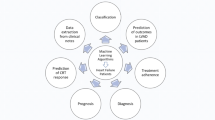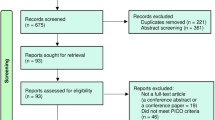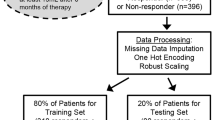Abstract
Purpose
Cardiac resynchronization therapy (CRT) has been established as an important therapy for heart failure. Mechanical dyssynchrony has the potential to predict responders to CRT. The aim of this study was to report the development and the validation of machine learning models which integrate ECG, gated SPECT MPI (GMPS), and clinical variables to predict patients’ response to CRT.
Methods
This analysis included 153 patients who met criteria for CRT from a prospective cohort study. The variables were used to model predictive methods for CRT. Patients were classified as “responders” for an increase of LVEF ≥ 5% at follow-up. In a second analysis, patients were classified as “super-responders” for an increase of LVEF ≥ 15%. For ML, variable selection was applied, and Prediction Analysis of Microarrays (PAM) approach was used to model response while Naïve Bayes (NB) was used to model super-response. These ML models were compared to models obtained with guideline variables.
Results
PAM had AUC of 0.80 against 0.72 of partial least squares-discriminant analysis with guideline variables (p = 0.52). The sensitivity (0.86) and specificity (0.75) were better than for guideline alone, sensitivity (0.75) and specificity (0.24). Neural network with guideline variables was better than NB (AUC = 0.93 vs. 0.87) however without statistical significance (p = 0.48). Its sensitivity and specificity (1.0 and 0.75, respectively) were better than guideline alone (0.78 and 0.25, respectively).
Conclusions
Compared to guideline criteria, ML methods trended toward improved CRT response and super-response prediction. GMPS was central in the acquisition of most parameters. Further studies are needed to validate the models.






Similar content being viewed by others
Abbreviations
- CABG:
-
Coronary artery bypass graft
- CAD:
-
Coronary artery disease
- CRT:
-
Cardiac resynchronization therapy
- ECTb4:
-
Emory Cardiac Toolbox Version 4.0
- ECG:
-
Electrocardiogram
- ESV:
-
Left ventricular end systolic volume
- GMPS:
-
Gated myocardial perfusion SPECT
- HF:
-
Heart failure
- IAEA:
-
International Atomic Energy Agency
- LBBB:
-
Left bundle branch block
- LV:
-
Left ventricle
- LVEF:
-
Left ventricular ejection fraction
- MI:
-
Myocardial infarction
- ML:
-
Machine learning
- NYHA class:
-
New York Heart Association Class
- OSEM:
-
Ordered subset expectation maximization
- PCI:
-
Percutaneous coronary intervention
- PSD:
-
Left ventricular phase histogram standard deviation
- SPECT:
-
Single photon emission tomography
References
Tsao CW, Aday AW, Almarzooq ZI, Alonso A, Beaton AZ, Bittencourt MS, et al. Heart Disease and Stroke Statistics-2022 Update: a report from the American Heart Association. Circulation. 2022;145:e153–639. http://www.ncbi.nlm.nih.gov/pubmed/35078371.
Tracy CM, Epstein AE, Darbar D, DiMarco JP, Dunbar SB, Estes NAM, et al. 2012 ACCF/AHA/HRS focused update of the 2008 guidelines for device-based therapy of cardiac rhythm abnormalities: a report of the American College of Cardiology Foundation/American Heart Association Task Force on Practice Guidelines and the Heart Rhythm Society. Circulation. 2012; 126:1784–800. http://www.ncbi.nlm.nih.gov/pubmed/22965336.
Normand C, Linde C, Singh J, Dickstein K. Indications for cardiac resynchronization therapy: a comparison of the major international guidelines. JACC Heart Fail. Elsevier Inc. 2018;6:308–16. http://www.ncbi.nlm.nih.gov/pubmed/29598935.
Bax JJ, Bleeker GB, Marwick TH, Molhoek SG, Boersma E, Steendijk P, et al. Left ventricular dyssynchrony predicts response and prognosis after cardiac resynchronization therapy. J Am Coll Cardiol. 2004;44:1834–40.
Delgado V, Van Bommel RJ, Bertini M, Borleffs JCW, Marsan NA, et al. Imaging relative merits of left ventricular dyssynchrony, left ventricular lead position, and myocardial scar to predict long-term survival of ischemic heart failure patients undergoing cardiac resynchronization therapy. 2011. http://circ.ahajournals.org/cgi/content/full/CIRCULATIONAHA.110.945345/DC1.
Shetty AK, Duckett SG, Ginks MR, Ma Y, Sohal M, Bostock J, et al. Cardiac magnetic resonance-derived anatomy, scar, and dyssynchrony fused with fluoroscopy to guide LV lead placement in cardiac resynchronization therapy: a comparison with acute haemodynamic measures and echocardiographic reverse remodelling. Eur Hear journal Cardiovasc Imaging. Eur Heart J Cardiovasc Imaging. 2013, 2022;14:692–9. https://pubmed.ncbi.nlm.nih.gov/23175695/.
Khan FZ, Virdee MS, Palmer CR, Pugh PJ, O’Halloran D, Elsik M, et al. Targeted left ventricular lead placement to guide cardiac resynchronization therapy: the TARGET study: a randomized, controlled trial. J Am Coll Cardiol. 2012;59(17):1509–18. https://doi.org/10.1016/j.jacc.2011.12.030.
Henneman MM, Chen J, Dibbets-Schneider P, Stokkel MP, Bleeker GB, Ypenburg C, et al. Can LV dyssynchrony as assessed with phase analysis on gated myocardial perfusion SPECT predict response to CRT? J Nucl Med. 2007;48:1104–11. http://www.ncbi.nlm.nih.gov/pubmed/17574987.
de Amorim FF, Peix A, Giubbini R, Karthikeyan G, Massardo T, Patel C, et al. Reproducibility of global LV function and dyssynchrony parameters derived from phase analysis of gated myocardial perfusion SPECT: a multicenter comparison with core laboratory setting. J Nucl Cardiol. 2022;29:952–61. https://doi.org/10.1007/s12350-020-02397-6. (Springer International Publishing).
Peix A, Karthikeyan G, Massardo T, Kalaivani M, Patel C, Pabon LM, et al. Value of intraventricular dyssynchrony assessment by gated-SPECT myocardial perfusion imaging in the management of heart failure patients undergoing cardiac resynchronization therapy (VISION-CRT). J Nucl Cardiol. 2021;28(1):55–64. https://doi.org/10.1007/s12350-018-01589-5.
Boogers MJ, Chen J, Van Bommel RJ, Borleffs CJW, Dibbets-Schneider P, Van Der Hiel B, et al. Optimal left ventricular lead position assessed with phase analysis on gated myocardial perfusion SPECT. Eur J Nucl Med Mol Imaging. 2011;38:230–8.
Udelson JE, Konstam MA. Ventricular remodeling fundamental to the progression (and regression) of heart failure. J Am Coll Cardiol. 2011, 2022;57:1477–9. https://pubmed.ncbi.nlm.nih.gov/21435517/.
Cohn JN, Ferrari R, Sharpe N. Cardiac remodeling-concepts and clinical implications: a consensus paper from an International Forum on Cardiac Remodeling. J Am Coll Cardiol. 2000, 2022;35:569–82. https://pubmed.ncbi.nlm.nih.gov/10716457/.
Gimelli A, Liga R, Giorgetti A, Casagranda M, Marzullo P. Stress-induced alteration of left ventricular eccentricity: an additional marker of multivessel CAD. J Nucl Cardiol. 2019, 2022;26:227–32. https://pubmed.ncbi.nlm.nih.gov/28353212/.
Zou J, Hua W, Su Y, Xu G, Zhen L, Liang Y, et al. SPECT-guided LV lead placement for incremental CRT efficacy: validated by a prospective, randomized, controlled study. JACC Cardiovasc Imaging. 2019;12:2580–3. http://www.ncbi.nlm.nih.gov/pubmed/31542533.
Juarez-Orozco LE, Knol RJJ, Sanchez-Catasus CA, Martinez-Manzanera O, van der Zant FM, Knuuti J. Machine learning in the integration of simple variables for identifying patients with myocardial ischemia. J Nucl Cardiol. 2020;27:147–55.
Haro Alonso D, Wernick MN, Yang Y, Germano G, Berman DS, Slomka P. Prediction of cardiac death after adenosine myocardial perfusion SPECT based on machine learning. J Nucl Cardiol. 2019;26:1746–54. http://www.ncbi.nlm.nih.gov/pubmed/29542015.
Cikes M, Sanchez-Martinez S, Claggett B, Duchateau N, Piella G, Butakoff C, et al. Machine learning-based phenogrouping in heart failure to identify responders to cardiac resynchronization therapy. Eur J Heart Fail. 2019;21:74–85. http://www.ncbi.nlm.nih.gov/pubmed/30328654.
Kalscheur MM, Kipp RT, Tattersall MC, Mei C, Buhr KA, DeMets DL, et al. Machine learning algorithm predicts cardiac resynchronization therapy outcomes: lessons from the COMPANION Trial. Circ Arrhythm Electrophysiol. 2018;11:e005499. http://circep.ahajournals.org/lookup/doi/https://doi.org/10.1161/CIRCEP.117.005499.
Jimenez-Heffernan A, Butt S, Mesquita CT, Massardo T, Peix A, Kumar A, et al. Technical aspects of gated SPECT MPI assessment of left ventricular dyssynchrony used in the VISION-CRT study. J. Nucl. Cardiol. 2021;28:1165–71. https://doi.org/10.1007/s12350-020-02122-3.
Henzlova MJ, Duvall WL, Einstein AJ, Travin MI, Verberne HJ. ASNC imaging guidelines for SPECT nuclear cardiology procedures: stress, protocols, and tracers. J Nucl Cardiol. 2016;23:606–39. http://www.ncbi.nlm.nih.gov/pubmed/26914678.
Zhou W, Tao N, Hou X, Wang Y, Folks RD, Cooke DC, et al. Development and validation of an automatic method to detect the latest contracting viable left ventricular segments to assist guide CRT therapy from gated SPECT myocardial perfusion imaging. J Nucl Cardiol. 2017;1–10. http://www.ncbi.nlm.nih.gov/pubmed/28353213.
Tibshirani R, Hastie T, Narasimhan B, Chu G. Diagnosis of multiple cancer types by shrunken centroids of gene expression. Proc Natl Acad Sci USA. 2002;99(10):6567–72. https://doi.org/10.1073/pnas.082099299.
DeLong ER, DeLong DM, Clarke-Pearson DL. Comparing the areas under two or more correlated receiver operating characteristic curves: a nonparametric approach. Biometrics. 1988;44:837–45. http://www.ncbi.nlm.nih.gov/pubmed/3203132.
Mesquita CT, Peix A, de Amorim FF, Giubbini R, Karthikeyan G, Massardo T, et al. Clinical and gated SPECT MPI parameters associated with super-response to cardiac resynchronization therapy. J Nucl Cardiol. 2022;29:1166–74. https://doi.org/10.1007/s12350-020-02414-8. (Springer International Publishing).
Henneman MM, Chen J, Ypenburg C, Dibbets P, Bleeker GB, Boersma E, et al. Phase analysis of gated myocardial perfusion single-photon emission computed tomography compared with tissue Doppler imaging for the assessment of left ventricular dyssynchrony. J Am Coll Cardiol. 2007;49:1708–14. http://www.ncbi.nlm.nih.gov/pubmed/17448373.
He Z, de Amorim Fernandes F, do Nascimento EA, Garcia EV, Mesquita CT, Zhou W. Incremental value of left ventricular shape parameters measured by gated SPECT MPI in predicting the super-response to CRT. J. Nucl. Cardiol. 2022;29:1537–46. https://doi.org/10.1007/s12350-020-02469-7.
Killu AM, Grupper A, Friedman PA, Powell BD, Asirvatham SJ, Espinosa RE, et al. Predictors and outcomes of “super-response” to cardiac resynchronization therapy. J Card Fail; 2014;20:379–86. https://pubmed.ncbi.nlm.nih.gov/24632340/.
Ypenburg C, van Bommel RJ, Borleffs CJW, Bleeker GB, Boersma E, Schalij MJ, et al. Long-term prognosis after cardiac resynchronization therapy is related to the extent of left ventricular reverse remodeling at midterm follow-up. J Am Coll Cardiol. 2009;53:483–90. http://www.ncbi.nlm.nih.gov/pubmed/19195605.
Rickard J, Kumbhani DJ, Popovic Z, Verhaert D, Manne M, Sraow D, et al. Characterization of super-response to cardiac resynchronization therapy. Hear Rhythm. 2010;7:885–9. http://www.ncbi.nlm.nih.gov/pubmed/20382271.
Ghani A, Delnoy PPHM, Adiyaman A, Ottervanger JP, Ramdat Misier AR, Smit JJJ, et al. Predictors and long-term outcome of super-responders to cardiac resynchronization therapy. Clin Cardiol. 2017;40:292–9. http://www.ncbi.nlm.nih.gov/pubmed/28294364.
Zecchin M, Proclemer A, Magnani S, Vitali-Serdoz L, Facchin D, Muser D, et al. Long-term outcome of “super-responder” patients to cardiac resynchronization therapy. Europace; 2014;16:363–71. https://pubmed.ncbi.nlm.nih.gov/24189477/.
Hsu JC, Solomon SD, Bourgoun M, McNitt S, Goldenberg I, Klein H, et al. Predictors of super-response to cardiac resynchronization therapy and associated improvement in clinical outcome: the MADIT-CRT (multicenter automatic defibrillator implantation trial with cardiac resynchronization therapy) study. J Am Coll Cardiol. 2012;59(25):2366–73. https://doi.org/10.1016/j.jacc.2012.01.065.
Chung ES, Leon AR, Tavazzi L, Sun J, Nihoyannopoulos P, Merlino J, et al. Results of the Predictors of Response to CRT (PROSPECT) trial. Circulation. 2008;117:2608–16. http://www.ncbi.nlm.nih.gov/pubmed/18458170.
Hung GU, Zou J, He Z, Zhang X, Tsai SC, Wang CY, et al. Left-ventricular dyssynchrony in viable myocardium by myocardial perfusion SPECT is predictive of mechanical response to CRT. Ann Nucl Med. 2021;35:947–54. https://doi.org/10.1007/s12149-021-01632-5. (Springer Singapore).
de Souza Filho EM, Mesquita CT. Phase analysis of gated myocardial perfusion SPECT and cardiac resynchronization therapy: the good, the bad, and the ugly. J Nucl Cardiol. 2021;28:1136–39. https://doi.org/10.1007/s12350-020-02056-w.
Nichols K, Santana CA, Folks R, Krawczynska E, Cooke CD, Faber TL, et al. Comparison between ECTb and QGS for assessment of left ventricular function from gated myocardial perfusion SPECT. J Nucl Cardiol. 9:285–93. http://www.ncbi.nlm.nih.gov/pubmed/12032476.
Acknowledgements
The authors thank the Vision CRT researchers for sharing the data and collaborating: Amelia Jimenez-Heffernan, Sadaf Butt, Claudio T. Mesquita, Teresa Massardo, Amalia Peix, Alka Kumar, Chetan Patel, Erick Alexanderson, Luz M. Pabon, Ganesan Karthikeyan, Claudia Gutierrez, Ernest Garcia, and Diana Paez.
Funding
This study presents the results derived from the International Atomic Energy Agency (IAEA) multicenter trial: “Value of intraventricular synchronism assessment by gated-SPECT myocardial perfusion imaging in the management of heart failure patients submitted to cardiac resynchronization therapy” (IAEA VISION-CRT), Coordinated Research Protocol E1.30.34, and received funds from IAEA. CTM receives grants from CNPq and FAPERJ. It was supported in part by a grant from The American Heart Association (Project Number: 17AIREA33700016, PI: Weihua Zhou) and by Michigan Technological University Undergraduate Research Internship Program (PI: Kristoffer Larsen).
Author information
Authors and Affiliations
Corresponding authors
Ethics declarations
Ethical approval
The study was approved by the participant countries’ scientific councils and complies with the Declaration of Helsinki. Written informed consent was obtained from all participants and patient anonymity was maintained during data analysis. In addition, we would like to state that (1) the paper is not under consideration elsewhere, (2) none of the paper’s contents have been previously published, (3) all authors have read and approved the manuscript, and that (4) the paper has been published as a preprint in arXiv and is available at http://arxiv.org/abs/2211.07472.
Conflict of interest
The authors declare no competing interests.
Additional information
Publisher's note
Springer Nature remains neutral with regard to jurisdictional claims in published maps and institutional affiliations.
Rights and permissions
Springer Nature or its licensor (e.g. a society or other partner) holds exclusive rights to this article under a publishing agreement with the author(s) or other rightsholder(s); author self-archiving of the accepted manuscript version of this article is solely governed by the terms of such publishing agreement and applicable law.
About this article
Cite this article
de A. Fernandes, F., Larsen, K., He, Z. et al. A machine learning method integrating ECG and gated SPECT for cardiac resynchronization therapy decision support. Eur J Nucl Med Mol Imaging 50, 3022–3033 (2023). https://doi.org/10.1007/s00259-023-06259-4
Received:
Accepted:
Published:
Issue Date:
DOI: https://doi.org/10.1007/s00259-023-06259-4




